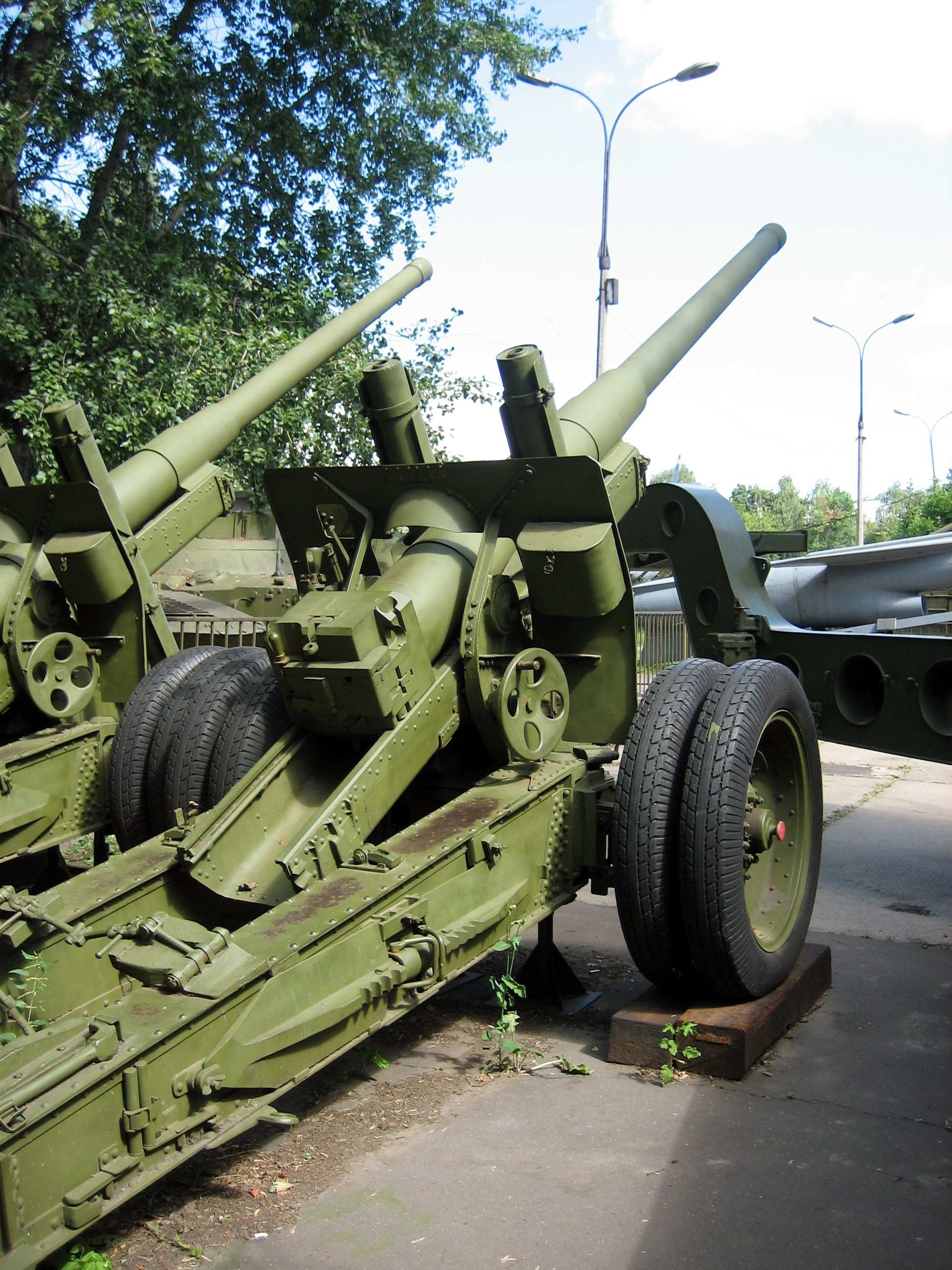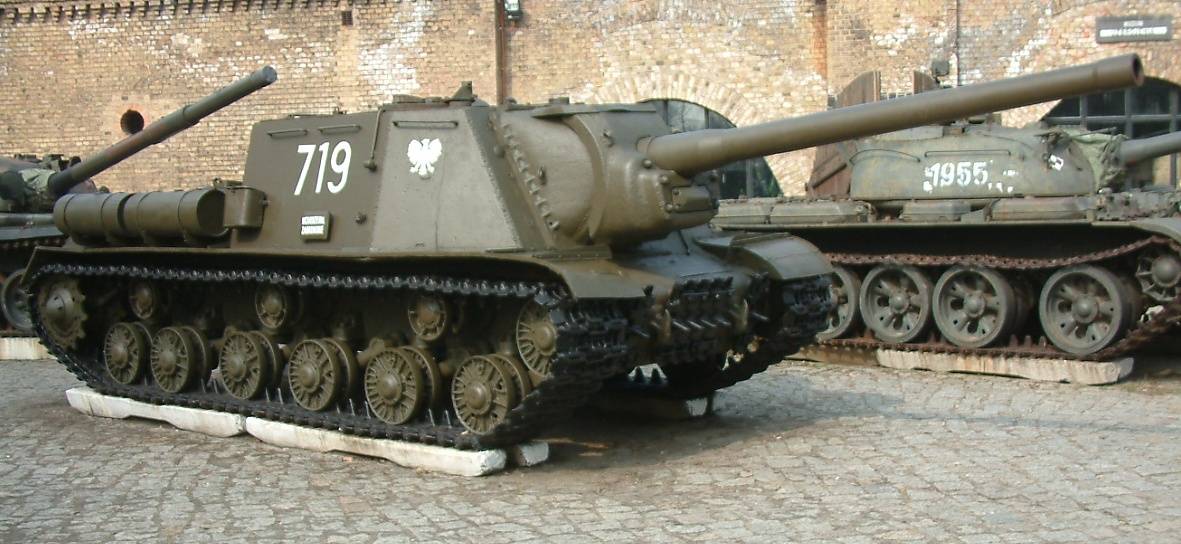|
D-25T
122 mm corps gun M1931/37 (A-19) (russian: 122-мм корпусная пушка обр. 1931/1937 гг. (А-19)) was a Soviet field gun developed in late 1930s by combining the barrel of the 122 mm gun M1931 (A-19) and the carriage of the 152 mm howitzer-gun M1937 (ML-20). The gun was in production from 1939 until 1946. It saw action in World War II (primarily with corps and RVGK artillery of the Red Army) and remained in service for a long time after the end of the war. Vehicle-mounted variants of the gun were fitted to the IS-2 and IS-3 tanks of the Iosif Stalin series of tanks and the ISU-122 self-propelled gun. Development history In 1936 the Red Army adopted the 122 mm gun M1931, also known as A-19. Unlike earlier ordnance pieces used by the Red Army, it had split trail carriage with suspension, and consequently improved mobility and traverse. The carriage of M1931 had a number of shortcomings though. The elevation mechanism was slow and unreliable; solid-tired ... [...More Info...] [...Related Items...] OR: [Wikipedia] [Google] [Baidu] |
IS-2
The IS-2 (russian: ИС-2, sometimes romanized as JS-2The series name is an abbreviation of the name Joseph Stalin (russian: Иосиф Сталин); IS-2 is a direct transliteration of the Russian abbreviation, while JS-2 is an abbreviation of the English or German form of Stalin's name.) is a Soviet heavy tank, the first of the IS tank series named after the Soviet leader Joseph Stalin. It was developed and saw combat during World War II, and saw service in other Soviet allied countries after the war. Design and production Object 237 KV-85 and IS-85/IS-1 The KV-1 was criticized by its crews for its poor mobility and the lack of a larger caliber gun than the T-34 medium tank. It was much more expensive than the T-34, without having greater combat performance. Moscow ordered some KV-1 assembly lines to shift to T-34 production, leading to fears that KV-1 production would be halted and the SKB-2 design bureau, led by Kotin, closed. In 1942, this problem was partially addres ... [...More Info...] [...Related Items...] OR: [Wikipedia] [Google] [Baidu] |
Iosif Stalin Tank
The IS tanks (russian: ИС) were a series of heavy tanks developed as a successor to the KV-series by the Soviet Union during World War II. The IS acronym is the anglicized initialism of Joseph Stalin (, '). The heavy tanks were designed as a response to the capture of a German Tiger I in 1943. They were mainly designed as breakthrough tanks, firing a heavy high-explosive shell that was useful against entrenchments and bunkers. The IS-2 went into service in April 1944 and was used as a spearhead by the Red Army in the final stage of the Battle of Berlin. The IS-3 served on the Chinese-Soviet border, the Hungarian Revolution, the Prague Spring and on both sides of the Six-Day War. The series eventually culminated in the T-10 heavy tank. Design and production KV-85 IS-85/IS-122 and IS-2 The KV-85 heavy tank was a modification of the KV-1S heavy tank. The tank was a result of the USSR's tank design bureau being torn in two, one half focusing on the KV-85 and its variants, ... [...More Info...] [...Related Items...] OR: [Wikipedia] [Google] [Baidu] |
ISU-122
The ISU-122 (acronym of'' Istrebitelnaja - or Iosif Stalin-based - Samokhodnaya Ustanovka 122'') was a Soviet assault gun used during World War II, mostly in the anti-tank role. History and purpose A prototype of the ISU-122 (in Russian ИСУ-122) heavy self-propelled gun was built at the Chelyabinsk Kirov Plant (''Chelyabinskiy Kirovskiy Zavod (ChKZ)'', Chelyabinsk, Russia), in December 1943. The design shared the chassis of the ISU-152 self-propelled gun and differed only in armament, having an A-19S 122-mm gun as its main weapon instead of the ISU-152's ML-20S gun-howitzer. Towed versions of these guns used the same carriage: 52-L-504A (Russian designation 52-Л-504А), so installation of an A-19 instead of an ML-20 gun was not a difficult task. After completing development of the ISU-152, ChKZ engineers mounted the A-19 gun on the ISU-152 chassis to create ''"Object 242"'' — the first ISU-122 prototype. It was successfully tested, but not immediately launched into mass p ... [...More Info...] [...Related Items...] OR: [Wikipedia] [Google] [Baidu] |
Komintern Artillery Tractor
The T-24 was a Soviet medium tank built in 1931. Only twenty four were built, and none saw combat. This was the first tank produced at the KhPZ factory in Kharkov, which was later responsible for the very successful BT series, T-34 and T-54 Soviet tanks. The T-24's suspension was used successfully in the Soviet Union's first purpose-built artillery tractors. The T-24's main armament was a 45 mm gun. It had a ball-mount 7.62 mm DT machine gun in the hull, another in the turret, and a third in a secondary turret atop the main turret. The tank was well-armoured for its time, but the engine and transmission had problems. Production history A tank design bureau was established at the Kharkov Locomotive Factory (KhPZ) in Kharkov, Soviet Ukraine, in 1928. The first tank project of the factory was the T-12 (or T-1-12). This was a larger version of the T-18, with a more powerful engine (the T-18 was based on the Renault FT). The idea of the T-24 tank was so great, in A ... [...More Info...] [...Related Items...] OR: [Wikipedia] [Google] [Baidu] |
Artillery Tractor
An artillery tractor, also referred to as a gun tractor, is a specialized heavy-duty form of tractor unit used to tow artillery pieces of varying weights and calibres. It may be 6x6, wheeled, continuous track, tracked, or half-tracked. Traction There are two main types of artillery tractors, depending on the type of traction: wheeled and tracked. * Wheeled tractors are usually variations of truck, lorries adapted for military service. * Tracked tractors run on continuous track; in some cases are built on a modified tank chassis with the superstructure replaced with a compartment for the gun crew or ammunition. In addition, half-track tractors were used in the interwar period and in World War II, especially by the Wehrmacht. This type of tractor was mostly discontinued postwar. History World War I The first artillery tractors were designed prior to the outbreak of World War I, often based on agricultural machines such as the Holt tractor. Such vehicles allowed the tact ... [...More Info...] [...Related Items...] OR: [Wikipedia] [Google] [Baidu] |
Gun Shield
A U.S. Marine manning an M240 machine gun equipped with a gun shield A gun shield is a flat (or sometimes curved) piece of armor designed to be mounted on a crew-served weapon such as a machine gun, automatic grenade launcher, or artillery piece. Military Some mounted machine guns and artillery pieces are equipped with metal armor plates to protect the gunners from small arms fire and shrapnel from explosions. They were fitted to some armored fighting vehicles and patrol boats during the Vietnam War. Gun shields fell out of widespread use after the Vietnam war, but they have seen a resurgence in popularity during the 1990s. Israeli military analysts began urging the use of gun shields, pointing to the grave risk to soldiers exposed to fire from automatic weapons. In particular, it was noted that many casualties were hit in areas not protected by body armor or a helmet, such as the neck or face. The U.S. began using gun shields during the 2000s-era wars in Iraq and Afghanista ... [...More Info...] [...Related Items...] OR: [Wikipedia] [Google] [Baidu] |
Tire
A tire (American English) or tyre (British English) is a ring-shaped component that surrounds a Rim (wheel), wheel's rim to transfer a vehicle's load from the axle through the wheel to the ground and to provide Traction (engineering), traction on the surface over which the wheel travels. Most tires, such as those for automobiles and bicycles, are pneumatically inflated structures, which also provide a flexible cushion that absorbs shock as the tire rolls over rough features on the surface. Tires provide a footprint, called a contact patch, that is designed to match the weight of the vehicle with the bearing strength of the surface that it rolls over by providing a bearing pressure that will not deform the surface excessively. The materials of modern pneumatic tires are synthetic rubber, natural rubber, fabric, and wire, along with carbon black and other chemical compounds. They consist of a tire tread, tread and a body. The tread provides Traction (engineering), traction ... [...More Info...] [...Related Items...] OR: [Wikipedia] [Google] [Baidu] |
Leaf Spring
A leaf spring is a simple form of spring commonly used for the suspension in wheeled vehicles. Originally called a ''laminated'' or ''carriage spring'', and sometimes referred to as a semi-elliptical spring, elliptical spring, or cart spring, it is one of the oldest forms of vehicle suspension. A leaf spring is one or more narrow, arc-shaped, thin plates which are attached to the axle and chassis in a way that allows the leaf spring to flex vertically in response to irregularities in the road surface. Lateral leaf springs are the most commonly used arrangement, running the length of the vehicle and mounted perpendicular to the wheel axle, but numerous examples of transverse leaf springs exist as well. Leaf springs can serve multiple suspension functions: location, springing, and to some extent damping as well, through interleaf friction. However, this friction is not well controlled, resulting in stiction and irregular suspension motions. For this reason, some manufacturers have ... [...More Info...] [...Related Items...] OR: [Wikipedia] [Google] [Baidu] |
Hydraulics
Hydraulics (from Greek: Υδραυλική) is a technology and applied science using engineering, chemistry, and other sciences involving the mechanical properties and use of liquids. At a very basic level, hydraulics is the liquid counterpart of pneumatics, which concerns gases. Fluid mechanics provides the theoretical foundation for hydraulics, which focuses on the applied engineering using the properties of fluids. In its fluid power applications, hydraulics is used for the generation, control, and transmission of power by the use of pressurized liquids. Hydraulic topics range through some parts of science and most of engineering modules, and cover concepts such as pipe flow, dam design, fluidics and fluid control circuitry. The principles of hydraulics are in use naturally in the human body within the vascular system and erectile tissue. Free surface hydraulics is the branch of hydraulics dealing with free surface flow, such as occurring in rivers, canals, lakes, estuar ... [...More Info...] [...Related Items...] OR: [Wikipedia] [Google] [Baidu] |


.jpg)
_Driver_and_Commander_from_A_Squadron%2C_3rd_Cavalry_Regiment.jpg)

.jpg)